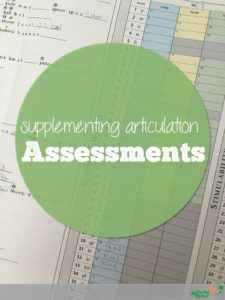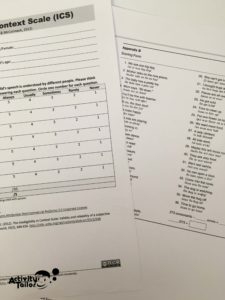Here we go again. The Kindergarten/1st grade screening letters are sent out and I’ll soon have several blurred days of kiddos and that constant, “did I ask you this already?” feeling.
And the artic assessments are right behind them, since those are the referrals I always seem to get first.
I assess with the Goldman-Fristoe. The second edition. I know, I know. I need to update, but the online discussions with other therapists about the time increase and the large discrepancy in scores has kept me wary. (I am planning to attend a one hour session at ASHA done by Pearson, so there’s a strong likelihood I’ll convert soon. I want to.)
The GF-2, as we all know, is a quick to administer and score test and generally I feel like the scores are a fairly accurate representation of what I’m hearing. Not always, but usually.
The tough situations are the kiddos with an atrocious production of a frequently used phoneme (/r/ anyone?), that don’t look too bad score-wise, but are really hard to understand in conversation. The kiddos that really kill me are the ones that miraculously have “rabbit” but no /r/ anywhere else. Not even a hint of one. Am I the only one this has happened to?
To capture this scenario, I started calculating a “percent consonant correct” (PCC) and including it in my reports several years ago. If you aren’t familiar with the term it means exactly what it says—how many consonants are produced correctly as a percentage of the total produced. Typically this is calculated from a 10-15 minute conversation.
But who has time to gather and then transcribe a language sample? A 10-15 minute sample, depending on the kid, could be anywhere from 2 to a million words. And it’s not unlikely that there will be several words within the sample that I have no idea what they are. They are coming for intelligibility issues after all.
So I was delighted, really delighted, when I came across an article in the American Journal of Speech-Language Pathology, “An Objective and Time-Efficient Method for Determiningh Severity of Childhood Speech Delay” by Johnson, Weston and Bain (Vol. 13, February 2004, pgs. 55-65). I can’t link to the article directly, but you can find it on asha.org. Click under “Publications” and then on the appropriate journal. It will ask you to login with your ASHA account.
Stick with me, don’t let “journal” scare you off.
Without getting into all the particulars, let me just say that the authors made a case for using 36 imitative sentences (more efficient, more control over the variety of phonemic context) over spontaneous conversation. Well, hallelujah! This I can do!
This extra assessment piece takes just a couple of moments to complete and the phonetic transcriptions are already provided so you are simply crossing off the errored consonants. Tally the number of errors, subtract from the total consonants (273) and divide by 273 to get the PCC. Easy as can be.
Assuming the child is old enough that all or most speech sounds would typically be in place, generally scores down to 85% are considered mild; scores between 65-85% mild-moderate; 50-65% moderate-severe; below 50% severe.
The list of sentences and their transcriptions are Appendix B in the article and easily photocopied for administration. I also like using this as a comparison of intelligibility over time and it would work with adults as well as children.
This year, after taking the online course on Improving Intelligibility in Children with Speech Sound Disorders, I’ll also be adding one more component—the Intelligibility in Context Scale (ICS). This seven item questionnaire is generally filled out by the parent or primary caregiver and has them rate intelligibility on a 5 point scale across a variety of situations—like “how often do you understand your child?” to “do strangers understand your child?”
Calculating the score for this is simply an average and by the time a child is 4-5 years of age you would expect the percentage to fall in the usually to always category (the mean was a score of 4.4).
The scale has been translated into lots of different languages and can also be adapted to use with adults. To check it out, click here. I think this is going to add another component that makes my reports more comprehensive.
So what are you up to? Anyone else feel the wave of articulation referrals cresting just beyond them? Any additional tips you have to share or an opinion on the new G-F?








This Post Has 16 Comments
I didn’t know about this little instrument, but it sure sounds promising for gathering additional information on how a child articulates. In addition to the GFTA, I would also use the PAT (Photo Articulation Test) as a second test. However, it was still basically a naming test. I wasn’t getting a conversational sample of all phonemes.
Thanks for sharing both of these assessment tools! I often find myself doing significant amounts of informal assessments for artic evaluations (more than I probably need) because I don’t feel like I have enough formal options without it being repetitive. The informal piece is equally important and will continue, but this will allow me to feel more comfortable with having the right balance of formal and informal. I appreciate you sharing your ideas and knowledge! Thanks again.
Thanks for the feedback, Sara!
I could not find the article. Could you please give me the name of the article? Thanks!
Hi, Kendra! It’s “An Objective and Time-Efficient Method for Determining Severity of Childhood Speech Delay.” Kim
This is great information to supplement the standardized artic tests. Thanks 🙂
Glad it works for you!
I have been using the An Objective and Time-Efficient Method for Determiningh Severity of Childhood Speech Delay sentences for several years now as a routine part of all my speech sound production assessments. I reference the PCC score I obtain on the child to the information from the Sharynne McLeod and
Ken Bleile document titled “Neurological and developmental foundationsof speech acquisition” that lists typical PCC scores for children of various ages. This McLeod and Bleile document is a great resource for normative information on speech sound production and can easily be found on the internet by searching for the authors and the title.
Wow. This sounds amazing. The only issue I have is that I am not a member of ASHA and; therefore, am unable to access this. Is there any other way that the document can be shared? Thank you in advance!!!
There’s not another way to share it, but I believe each journal has rates for a single download. Hope that helps! Kim
Thank you!
Thanks for this great information! Regarding the GFTA-3, you will find that those kiddos with /r/ issues are captured in the scoring, obtaining shockingly low standard scores with just /r/ errors. The protocol form that originally came with the GFTA-3 is very unwieldy; there are no nice columns to see initial, medial, and final errors. I understand that if you order the GFTA-3 now, there is a re-structured protocol form that shows initial, medial, and final errors in a table format. I wish Pearson (publisher) had informed those who bought this test earlier that there is an updated protocol form. I didn’t find out until a colleague noticed the difference between her newly-purchased GFTA-3 protocols, and my earlier-purchased ones.
Thank you sooo much for this info! The complaints about the form had me very reluctant to make the shift. Kim
This information is great! Thanks so much for sharing it!
I am getting a different total consonant count (not 273) when I count up the consonants on the Scoring Form provided in the Appendix to the Johnson, et al. article. The transcriptions provided are throwing me off, since /r/-controlled vowels are sometimes counted as consonants. How do you handle the count? Thanks!
Trish, If you have questions about how the instrument was designed, I’d suggest you read the entire journal article or try to contact one of the authors. I’ve been using it as directed and did not go back to double check counts–I trust in the researchers for the details like that! Thanks for pointing it out, Kim
Comments are closed.